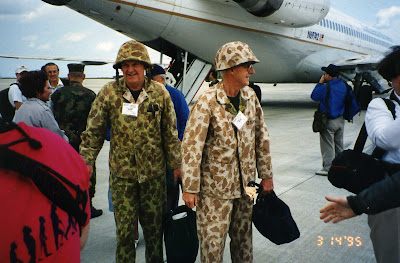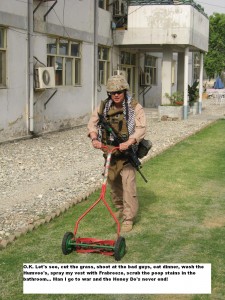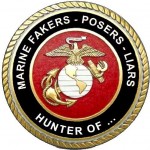Iwo Jima 1995
February 24th, 2008 Posted in The SandGram v1.0
Back in 1995, I was involved in the “Okinawa Plus Fifty Committee” with my close friend Jim Adams. Basically we were the guys who were trying to help set up the return of the WWII veterans to Okinawa, and let them face their enemy who are now our allies after all these years. Because of the press for this and my love of history, the Squadron Commanding Officer asked if I would lead a battle study of another battle…the fight for Iwo Jima. When he asked if I could take this on, my first reaction was “Does a bear piss in the woods? You betcha, Sir!”
I had spent the better part of six months digging up old Japanese caves with a couple other Marines (another story, another time) finding bones of dead soldiers and turning them into the local authorities. To find all these hidden caves, I poured over old maps of the battlefields and would take off at four am to make my way down south of Naha Okinawa, to the ridge lines where the Marines and Japs fought. This type of battlefield study discipline allowed me to put together an all day event on the island of Iwo Jima. I had a close bond with the island when I was commissioned a 2nd Lt and a retired Marine Corps Colonel from our church, James A. Michener, showed up with a big box. “Taco, now that you are a Marine, I guess I need to pass some of this from one Marine to another.” He opened up the box and out came his Mameluke Marine Officer Sword, his name down the side and authentic aged ivory handles that were yellowed from time, his uniform from the battle of Iwo Jima, and his Colt .45 that he carried there (he kept that though for home protection). He was with the fifth division when they hit the beach, and he told me about the battle. About the shells, the absolute chaos, and the screams of the wounded as he advanced, and the men he killed.
His eyes watered as he told me this story and I was a twenty-two year old at a complete loss. I had known Mr. Michener all my life, and never knew that he was a Marine much less that he had fought on Iwo. He was the scary, retired school teacher that growled at us kids for running in the building as children, and now he was entrusting me with his uniform and sword. The history of it all, his .45 took many a Japanese life during the senseless Bonsai attacks those first couple of days on the island and carried with it,some ghosts for him I think. LtCol. Michener escaped major damage during WWII and went from a 2nd Lt to Major in two years, only to be medically retired after the Korean War from injuries sustained in combat there. For the chance to visit his island for him since he was in a nursing home at the time, I was willing to spend many a night reading all the books of the battle that I could find, and memorizing all the facts that I could.
The visit to the island was a success that fall, and we promoted thirty enlisted Marines from the Squadron on top of Mt. Suribachi. That was truly a powerful moment in my life. I have to say that the next was being allowed to attend the fiftieth anniversary of the actual battle of Iwo Jima “as a good deal trip” since it was my last flight in VMGR 152 in the KC-130F while stationed on Okinawa.
We took off a week prior to the event, and loaded a ton of stuff in the back of the plane for the ceremonies that were to take place that day. I took advantage of my free time there, and set out on foot, going through many of the caves on the island. I was fully equipped with a miner’s helmet and light, water and camera. The difference of this battlefield and all others is the fact that most of the island is just as it was in 1945. The Japs aren’t big on exploring, and there hasn’t been much of an American presence there all these years. I found all sorts of stuff while on the island, of course we left it where we found it to honor the dead, but it was still amazing. The caves were wide enough for two men to walk shoulder to shoulder in and the temperature was well over a hundred degrees because of the geo thermal activity on the island. It was hard to imagine what the Japanese Soldiers endured as we bombed the living hell out of the island. They had carved out sleeping beds in the walls for the Soldiers to crawl into or to put the wounded. It was incredible to walk for what seemed like miles through these caves. While we were there, they had discovered a medical cave by accident with thirty mummified Japanese Soldiers who all wrote letters home to their families knowing that they wouldn’t live since the entrance was caved in. I wondered if this was the basis of Clint Eastwood’s movie “Letters from Iwo Jima.” 
When the vets of Iwo arrived, they flew in old Continental Micronesia airlines 727’s to the Island. All the Marines on the Island formed a Congo reception in front of the hangers as the vets formed a single line and shook all of our hands. One of them said “yep, fifty years and we still have to wait around in a line, nothing changes much in the Corps.” I ended up with a bruise on my right hand after being crushed by 700 vets still firm grips. The reactions were varied, many cried, lots of somber faces, and lots of guys that were happy to see old friends. They all had to turn in their passports to the Japanese officials in the hanger to get a stamp which got a lot of old emotions stirring, not a good thing after all these years, and after that it was off to the races. We loaded the vets in trucks and took them down to the invasion beach for a big ceremony. All of them carried jars to collect some volcanic sand, and took a million pictures. That happened to also be the day that General Krulack took office as the 31st commandant of the Marine Corps, and what a mess that caused. They closed off Mt. Suribachi for this event for two hours, and that made some of the old timers ready to storm the mountain again.
I guess the most touching thing that happened to me was while driving back to the airstrip. I took the long way around the North part of the island to see the concrete ships that were still beached along the shoreline. We found this eighty-plus-year-old man walking by himself along the road (a big no-no for them in case they died and we couldn’t find them). We pulled up in our jeep and I said, “Sir, are you OK? You are a long way from the beaten trail and it’s pretty hot out here.” He looked over at me and replied, “Skipper, I was stuck in a foxhole very near here for two days with my best friend, surrounded by Japs. We couldn’t get out. I’m just trying to find it again and leave this for my friend. He died that first night, and I fought to make sure that I got his body out, and buried proper like.” He had a little cross with his friends name in it. I agreed to drive him, and help him find the hole if he would come with us and drink some water. He described the tree trunk that was on the south end of the fox hole that was actually a bomb crater hole. You know, it’s been fifty years, and I didn’t think he would find it again. At least the chances were very slim, but by God, he told us to stop the jeep at a certain point. We started walking out in this one area and about two hundred yards off the road we found his pit with the tree trunk still showing signs of massive bullet barrages. He placed the cross in the hole next to the tree and wept. We had to help him back to the jeep after that, most of his energy sapped as we drove him back to the hangers on the airfield.
Charles Lindberg and his wife’95
Before the trip out to the Island, I went to the Intel weenies and asked for the largest chart of Iwo Jima that they had, and then had it laminated. That evening, all the vets were in the hanger for the speeches and dinner. The Japs about caused the second invasion of Iwo when we found out that all the passports were just dumped into several boxes, not sorted by plane or anything. So they had to line all the vets around this very large hanger, get to the head table and call out a name. “Bob Smith” followed by thirty Marines scouring a table with passports looking for this individual. The blunder by the Japs, turned into my advantage as I approached each vet with poster in hand and said “Sir, I’d be honored if you would sign my poster.” They all wanted to put their name where they were wounded, but I talked them into signing right down from top to bottom.
I had the honor of meeting Charles W Lindberg, the last of the original flag raisers from that fateful day Feb 23rd 1943, who recently passed away. He and his wife were there, and the nicest folks you ever had the chance to meet. He handed me his card and said, “Captain Bell, if you ever make it to St. Paul MN, please look me up.” I never thought I’d see him again but as it turns out, I flew up there all the time for the Marines while on recruiting duty in Kansas City MO, and took him flying one cold day. I was even able to visit them while on layovers during my time up there with my airline since they lived about ten minutes from the airport. His house was full of paintings and pictures of the battle, and he’d show them all to you. It was always humbling, and an honor to be in his presence along with all those men I met that day in 1995 on Iwo Jima. I have to say that there won’t be a day that goes by that my children won’t pay honor to these men as I have that poster hanging in my office, and one day it will go to the Marine Museum in Quantico.

So on this day, during the heat of the battle so many years ago, let us all take a minute to pay tribute to the greatest generation of Americans to ever live. For with everyday that passes we lose another vet to age who now guard the gates of heaven.
Semper Fi to you all!!
LtCol Bell
Tags: The SandGram v1.0





